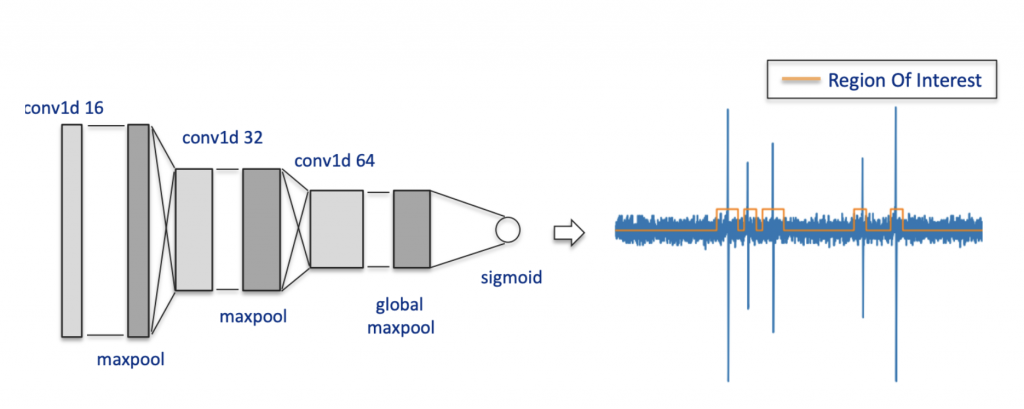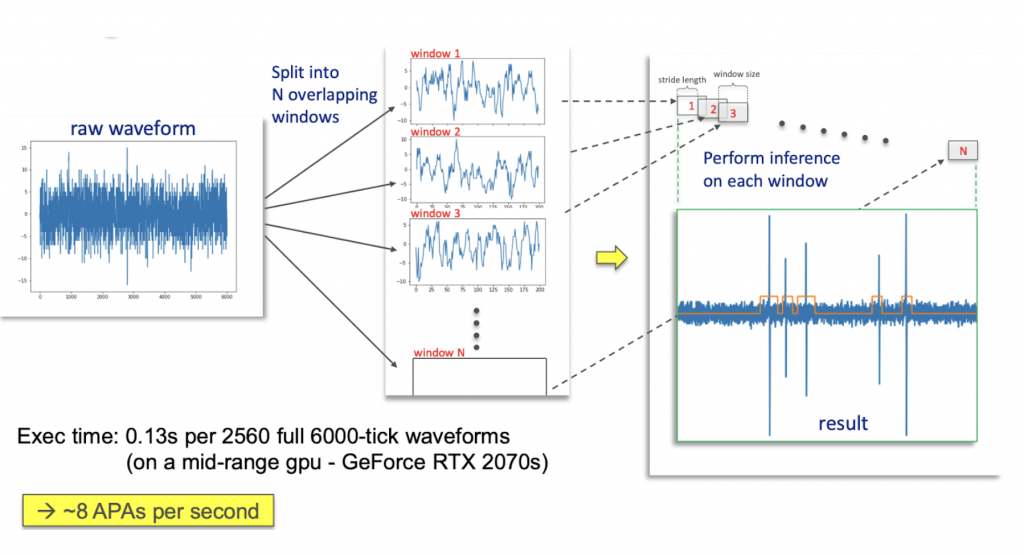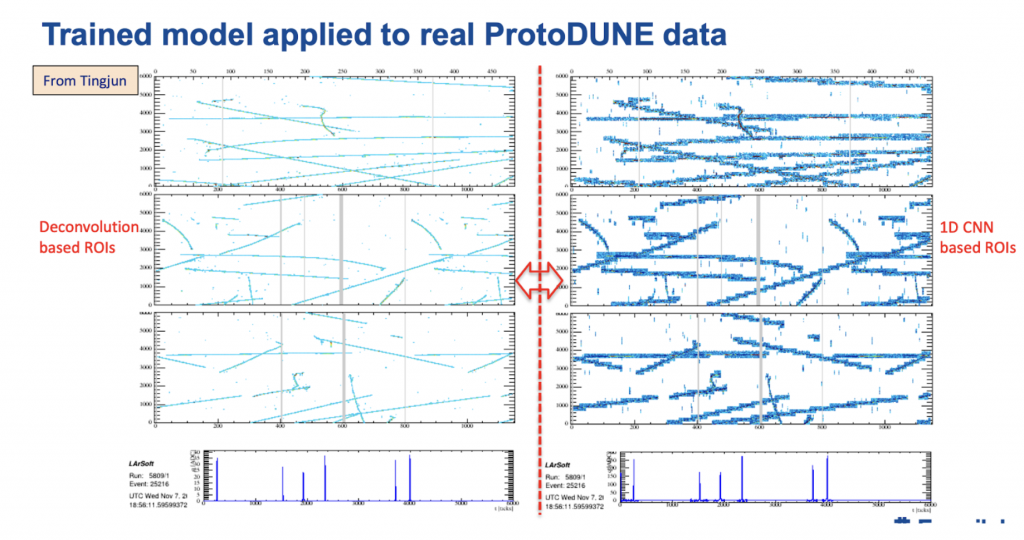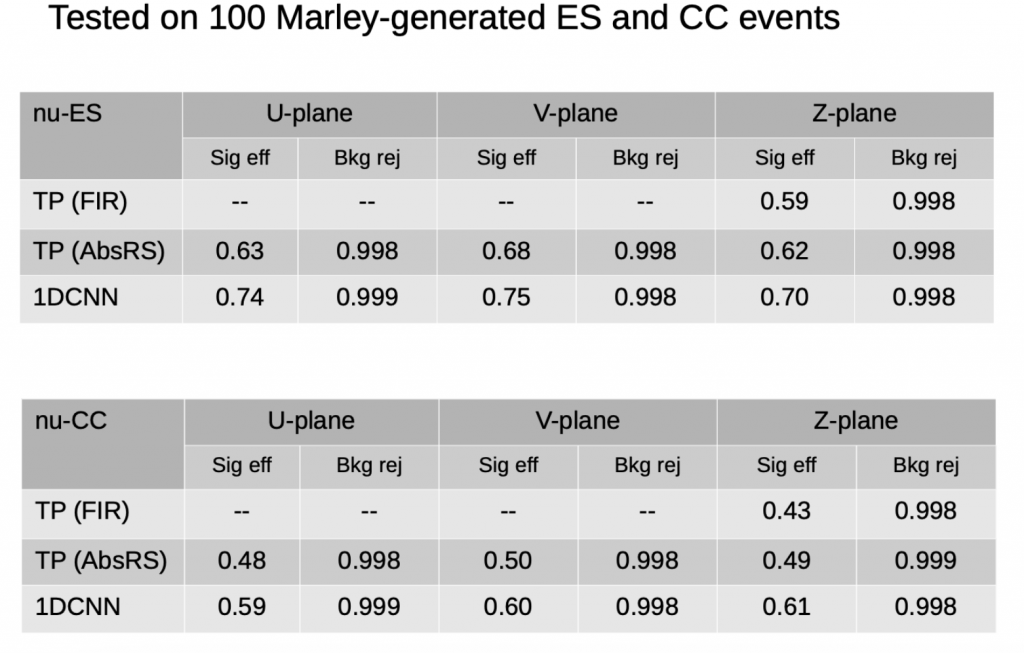This material is based on the following papers:
- L. Uboldi, et al., “Extracting low energy signals from raw LArTPC waveforms using deep learning techniques — A proof of concept”, Nucl.Instrum.Meth. A, 1028, 2022, https://www.sciencedirect.com/science/article/abs/pii/S016890022200047X
- R. Accari, et al., ArgoNeuT Collaboration, “A deep-learning based raw waveform region-of-interest finder for the liquid argon time projection chamber”, JINST 17 P01018, https://arxiv.org/abs/2103.06391
- A machine-learning based raw waveform ROI Finder in LArSoft presentation at the May 5, 2020 LArSoft Coordination meeting.
The next generation of large LArTPC neutrino detectors offer tremendous opportunities to observe and study a variety of low-energy phenomena, such as core-collapse supernova neutrinos, solar and atmospheric neutrinos, nucleon decays, etc. Even after signal processing to reduce noise and eliminate drift field effects, however, extracting these small signals is challenging due to irreducible background from low-level noise. While Deep Neural Nets (DNNs) are known to be effective at extracting various signals from 2D LArTPC images after signal processing, we have developed a 1D-Convolutional Neural Network (CNN) that can extract small signals by looking directly at raw waveforms from single LArTPC wires. That these signals can be extracted prior to computationally intensive signal processing makes this technique potentially valuable at the trigger level.
Early work focused on using a 1DCNN to discriminate signal from noise in simulated DUNE data. After obtaining promising results, the technique was extended to determine the location of the signal within a Region Of Interest (ROI) in the waveform. Figure 1 shows a simplified architecture of the resulting 1DCNN, along with identified regions of interest. A more detailed description of the 1DCNN can be found on https://larsoft.org/1dcnn/.
Figure 1: Basic architecture of the 1DCNN (left) used to identify ROIs (in orange) in a raw waveform (right). The spikes in the waveform are simulated signals. See A machine-learning based raw waveform ROI Finder presentation for more details.
The algorithm is applied by first breaking the waveform into overlapping windows, then performing the inference on each window to build the ROIs, as shown in Fig. 2.
Figure 2: Application of the ROI finding algorithm to a raw waveform. The input is split into overlapping time windows, which are then input into the 1DCNN. The resulting output ROIs are then constructed from the outputs from each individual window.
Training and validation was carried out using simulated ProtoDUNE samples. Testing was then performed on an independent, ~35k waveform sample. Those results found an overall test accuracy of 0.93, with 0.977 and 0.879 correctly identified signal and noise regions, respectively,
Fig. 3 shows the trained algorithm applied to raw waveforms from ProtoDUNE SP data (right), compared to a more conventional algorithm operating after full signal processing and deconvolution on the same event (left). The two algorithms find essentially the same ROIs, though the thicker lines on the right demonstrate that the 1DCNN algorithm finds them with less precision in time. In exchange, the 1DCNN operates orders of magnitude more quickly, since it runs on the raw waveform rather than after the CPU-intensive signal processing computation. As a result, the 1DCNN algorithm can be implemented in early stages of offline reconstruction as a very effective filter or sophisticated zero-suppression algorithm, so later stages can implement more sophisticated signal processing on much less data. Simple CNN architecture can also be implemented in hardware for online use and deployed in front-end boards for intelligent filtering or as a trigger.
Figure 3: Event displays showing reconstructed ROIs in an event from ProtoDUNE SP. The display shows the image from the three sens wire planes stacked vertically with time / drift distance on the vertical axis, and wire number on the horizontal axis. The display on the left shows the results from an algorithm operating after full signal processing and deconvolution, while the one on the right shows the results from the 1DCNN operating on raw waveforms.
A comparison of more similar algorithms is shown in Table 1, which contains results from two more conventional threshold-based ROI algorithms with the 1DCNN ROI finder, where all three operate on raw waveforms. The data in this case is simulated, low-energy elastic and charged current interactions in ProtoDUNE where the interactions are generated by Marley to reflect the type of events one would expect from a core-collapse supernova. The results show that the 1DCNN algorithm has better efficiency at the same background rejection for all wire planes for both elastic and charged current interactions.
Table 1: Comparison of the efficiency and background rejection for two conventional algorithms operating on threshold-based trigger primitives from the raw waveforms – the finite impulse response filter (TP(FIR)) and the newer absolute running sum algorithm (TP(AbsRS) – to that of the 1DCNN ROI finder. The results are separated by wire plane in the ProtoDUNE SP detector, which includes two induction planes (U and V) and one collection plane (Z), and for two types of low-energy neutrino interactions, elastic scatters (nu-ES) and charged current interactions (nu-CC). The neutrino interactions were generated using the Marley neutrino event generator, and are the type of events expected from a core-collapse supernova. In a study applied to ArgoNeut, the authors show, “The efficiency of our 1D-CNN ROI finder is roughly twice that of a traditional ADC over-threshold algorithm in the very low energy region (∼0.03-0.1 MeV).” [https://arxiv.org/abs/2103.06391]
Information on using the 1DCNN raw waveform algorithm is at the LArSoft wiki page https://larsoft.github.io/LArSoftWiki/Using_raw_waveform



